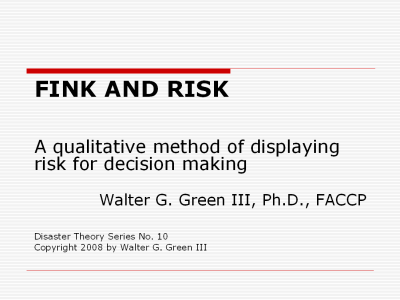| front |1 |2 |3 |4 |5 |6 |7
|8 |9 |10 |11 |12 |13 |14 |15 |16 |17 |18 |19 |20 |21 |review |
 |
In 1986 Steven Fink authored Crisis Management:
Planning for the Inevitable, one of the first business continuity and crisis
communications texts. In this volume he suggested a risk assessment tool
that has great utility in classifying hazards based on risk. For the
purposes of this presentation I will refer to this as Fink’s Matrix. Fink’s Matrix uses numbers to assign values of impact and probability to specific hazards or threats. I view this as a qualitative assessment, rather than quantitative, because of the importance of expert judgment in the assessment process. The user could equally well view, and promote, this tool as being an essentially quantitative one. The narrower the threat considered and the more accurate the data, the more this becomes quantitative rather than qualitative. Source: Fink, Steven, Crisis Management: Planning for the Inevitable, New York, New York, American Management Association, 1986. |